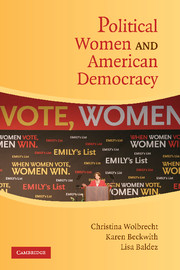Book contents
- Frontmatter
- Contents
- Preface
- List of Contributors
- Political Women and American Democracy
- 1 Introduction: What We Saw at the Revolution: Women in American Politics and Political Science
- 2 Gender as a Category of Analysis in American Political Development
- 3 Gender, Public Opinion, and Political Reasoning
- 4 Gender in the Aggregate, Gender in the Individual, Gender and Political Action
- 5 What Revolution? Incorporating Intersectionality in Women and Politics
- 6 Women's Movements and Women in Movements: Influencing American Democracy from the “Outside”?
- 7 Representation by Gender and Parties
- 8 Women as Candidates in American Politics: The Continuing Impact of Sex and Gender
- 9 Women as Officeholders: Linking Descriptive and Substantive Representation
- 10 Theorizing Women's Representation in the United States
- 11 Political Women in Comparative Democracies: A Primer for Americanists
- 12 Conclusion: Between Participation and Representation: Political Women and Democracy in the United States
- References
- Index
9 - Women as Officeholders: Linking Descriptive and Substantive Representation
Published online by Cambridge University Press: 05 September 2012
- Frontmatter
- Contents
- Preface
- List of Contributors
- Political Women and American Democracy
- 1 Introduction: What We Saw at the Revolution: Women in American Politics and Political Science
- 2 Gender as a Category of Analysis in American Political Development
- 3 Gender, Public Opinion, and Political Reasoning
- 4 Gender in the Aggregate, Gender in the Individual, Gender and Political Action
- 5 What Revolution? Incorporating Intersectionality in Women and Politics
- 6 Women's Movements and Women in Movements: Influencing American Democracy from the “Outside”?
- 7 Representation by Gender and Parties
- 8 Women as Candidates in American Politics: The Continuing Impact of Sex and Gender
- 9 Women as Officeholders: Linking Descriptive and Substantive Representation
- 10 Theorizing Women's Representation in the United States
- 11 Political Women in Comparative Democracies: A Primer for Americanists
- 12 Conclusion: Between Participation and Representation: Political Women and Democracy in the United States
- References
- Index
Summary
This chapter reviews the wealth of research on the behavior, experiences, and accomplishments of women in elective office in the United States to assess what we have learned and to identify some of the most promising avenues for future research. Motivated in large part by questions and concerns about women's political representation, this research has established a clear, empirical link between women's descriptive and substantive representation. Throughout the policy-making process – and beyond – female officeholders are often more likely than their male colleagues to act for women or women's interests. A closer look at this research also reveals that these links are by no means guaranteed or universal; descriptive representation is neither absolutely necessary nor entirely sufficient for substantive representation to occur. Some female officeholders are more likely than others to act for women; some male politicians are more likely than others to do so; some governing institutions are more likely than others to do so. Although few, if any, researchers would deny the imperfect nature of the relationship between women's descriptive and substantive representation, few (Dodson 2006; Dolan and Ford 1998; Reingold 2000) have made it their central focus.
Future research, I argue, needs to recognize and explore the complex, contingent, and gendered processes by which the linkages between the descriptive and substantive representation of women are strengthened or weakened.
- Type
- Chapter
- Information
- Political Women and American Democracy , pp. 128 - 147Publisher: Cambridge University PressPrint publication year: 2008
- 42
- Cited by



